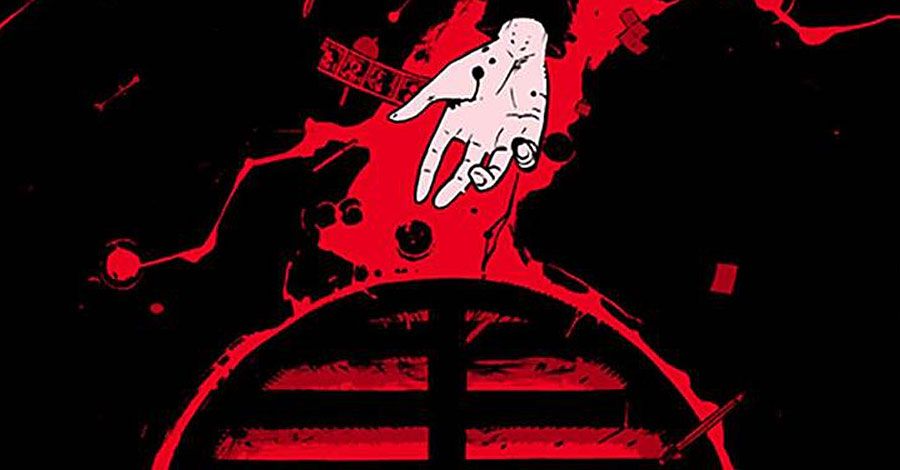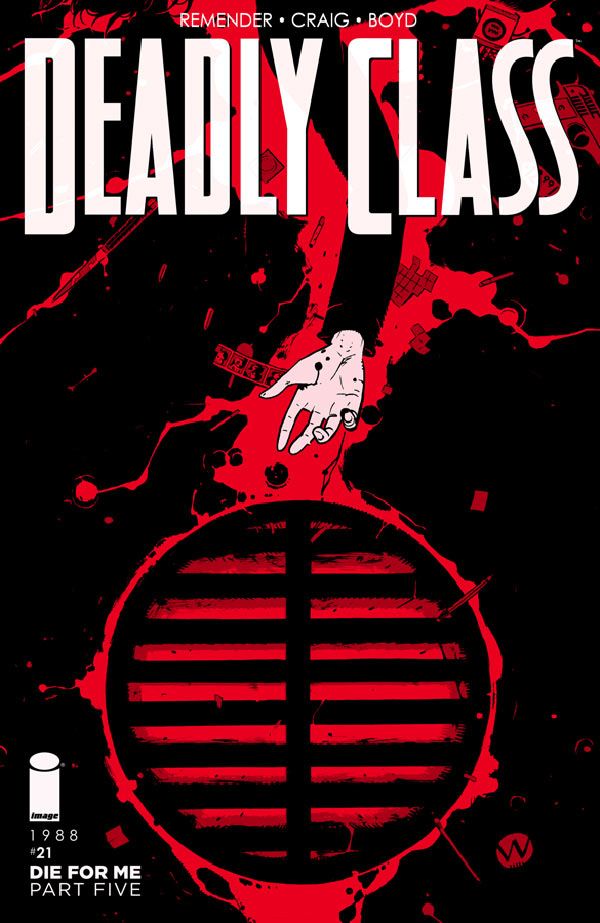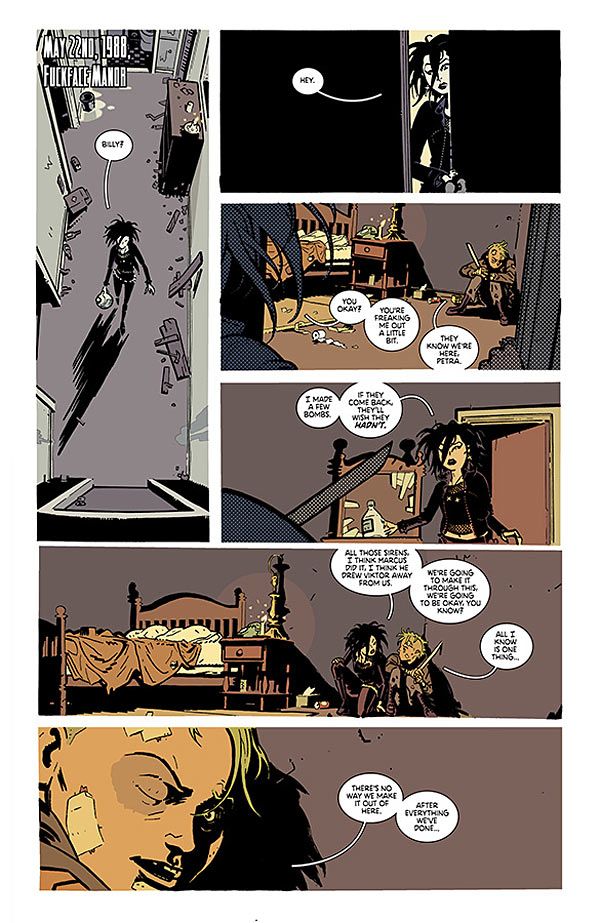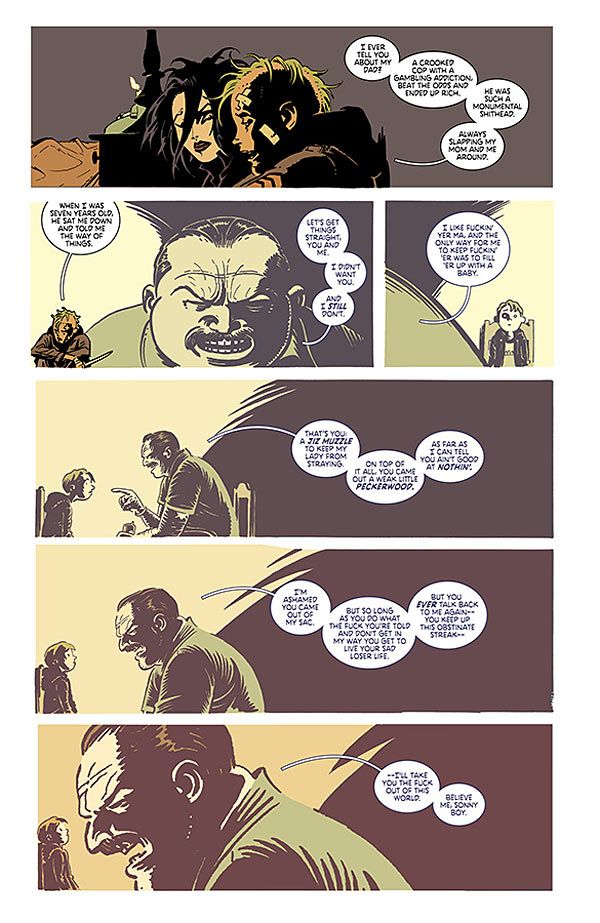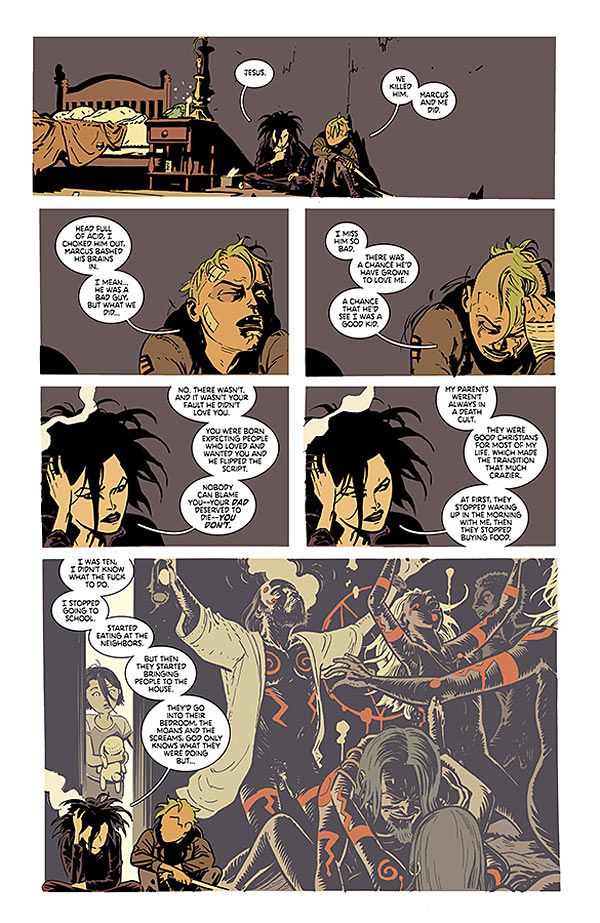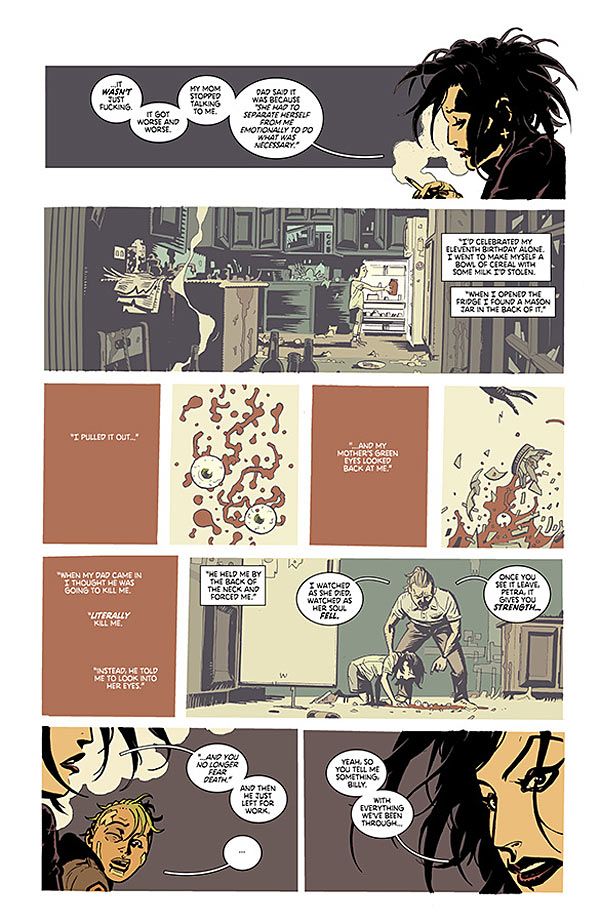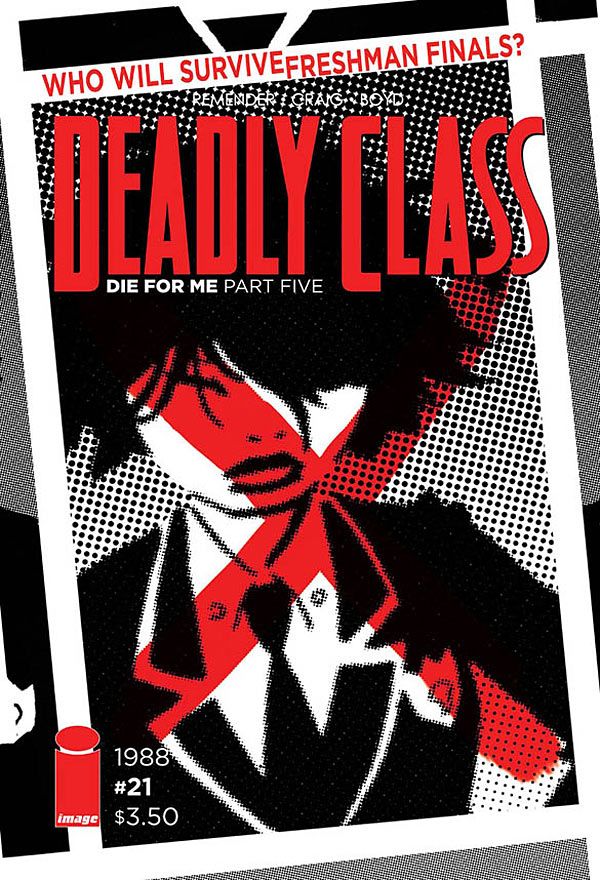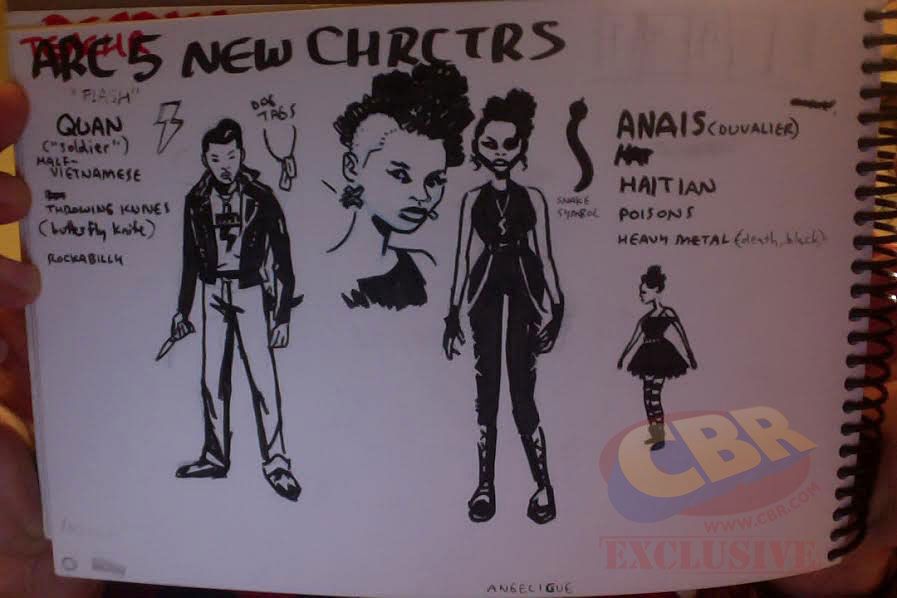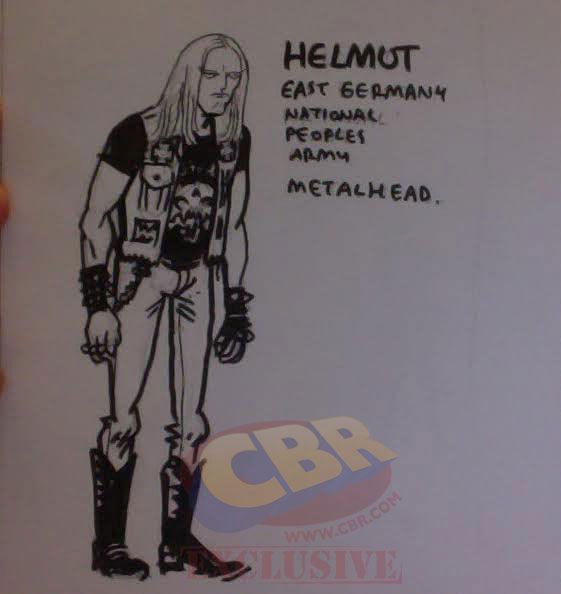SPOILER WARNING: The following interview contains major spoilers for "Deadly Class" #21, on sale now.
In "Deadly Class" #1, co-creators Rick Remender and Wes Craig introduced readers to homeless teenager Marcus Lopez Arguello and several other freshmen class members to Kings Dominion School for the Deadly Arts, a clandestine academy that transformed teenagers into assassins. In the issues that followed, the Image Comics series raised the stakes for its cast by embroiling Marcus and company in a number of harrowing exploits. More importantly, it raised the stakes for its readers as well, simply by allowing them to get to know the book's cast of teenage misfits. Readers learned of the cast's hopes, dreams, vices, virtues and tragic backstories -- which made it all the more painful when "Deadly Class" lived up to its title with Issue #21 and a beloved cast member perished.
RELATED: Remender Talks His & Murphy's "Tokyo Ghost," Says "#10 Is The End -- For Now
When Remender and Craig kicked off the "Die for Me" arc, Marcus and his surviving classmates faced a major turning point in their lethal education: Freshmen finals. The ordeal pitted members of the class against each other, and in Issue #21, those finals came to a violent and bloody conclusion, with many of the book's major cast members meet untimely ends.
CBR News: "Deadly Class" #21 featured a lot of shocking, and even tragic scenes. But perhaps the most tragic had to be Saya's accidental impalement of Marcus. Was this always going to be the way you closed out this chapter of the series?
Rick Remender: That wasn't an accident.
Oh?
Yeah, there was no accident there. She intended to kill him. Saya has a secret origin that we haven't told yet. She's going to graduate this school valedictorian no matter what it takes. That was sort of the B-story with Saya and Willie throughout this arc.
We saw Saya do anything she had to do to get through this and accomplish her goals. Plus, a few issues back, Master Lin told her if you don't go kill Marcus, you're not going to graduate -- and I'll probably have to punish you for your transgressions against the school by taking out some of your family members.
Saya was highly motivated. I kept that in sort of the background, so when we turn the page, the person who killed Marcus was somebody who made sense, but obviously had the most connection as well, so that it would hurt.
When she kills Marcus, Saya whispers something in his ear that we can't read because the text is so small. I tried to increase the size of the text to make out what she whispers, but I still couldn't read it. Is what she said a mystery that will be revealed?
[Laughs] That will be revealed. The Saya story is obviously going to take center stage for a little bit when we come back in a couple months. Saya is a character I've fallen in love with and am excited to get more into, but I wanted to do that when we could make her the focus of the book and shift things onto her. Now that we know what she's capable of, it's time to reveal a few of the mysteries about her.
We've seen back stories for pretty much every major character except her.
Right, and it's been hard to sit on her backstory because it's an interesting one, but we've had this plotted out for a while now. I knew when we got to this point it would allow us moving forward, to tell Saya's story, and it would shed a light on what happened here in this arc as well.
For most of the deaths in Issue #21, there was no doubt that these characters were gone. But with Marcus, you cut away and gave us what felt like a flashback. Can you definitively say that Marcus is dead?
He got stabbed in the heart with a sword, and he's a 15 year old kid. Also, that wasn't a flashback at the end -- that was an alt-version of reality, a final dream. That was the day he and his family went on the boat, and the schizophrenic woman jumped and killed his parents. Only in this version, when they said, "Hey, let's go do that," Marcus says, "I don't want to." And they say, "Okay, let's go for a walk in the park instead." So that's really sort of Marcus' last thoughts that you're getting at the end, which is as close to a happy ending as he was ever going to get.
What happens to Marcus is especially stunning because it comes right after another heart punch: the death of his friend, Willie. It felt like Marcus' heart to heart talk with Willie, and then his friend's death, had a profound emotional effect on him right before he died.
For sure. Those two characters and their friendship was a lot of the backbone of the series right up until this point, but that also led us to forget that they are in a place where nice people don't survive. They are in a place where the people who remain on top are there because they're rotten, and they're willing to do anything to hold on to their power. They're willing to do anything to win.
That scene was a bright light on Willie, to remember that he was just a good kid who was in the worst possible situation. The point behind that scene was that good people don't survive in this place.
Billy was murdered by Petra, who, really, revealed herself to be not such a nice person. The issue also gave us her backstory by revealing that her parents were part of a death cult. Those two scenes with Petra left me feeling sad for her, and a little terrified of her.
Perfect! That was another origin that I almost revealed in the last arc. I had a scene where she slept with Marcus, and I almost revealed her story there, but I felt like it would show my hand too much. You would see what she was capable of and how damaged she was.
There was a scene in Issue #17 where she poisons some cheerleaders, and as they're frothing and convulsing, she kneels over one of them and excitedly looks into their eyes. Marcus grabs her and pulls her away. That was my first hint as to her origin and just how damaged and crazy she is. Ultimately, though, I felt like saving all of that for right before the scenes with Billy had more impact.
That's the difficult thing when you're shifting around outlines; figuring out where those reveals are going to be most impactful. Ultimately, it felt like once I outlined this arc that pretty much all of the major things happen in the finale. It just all fit that way.
What inspired the creation of Petra?
I had a friend in high school who was a Goth. She obviously didn't have a backstory or anything like this, but she always hated the notion that Goths were considered mopey and depressive when actually what they were was angry. They're the same as punkers, latchkey kids and any kids who were neglected and angry at the overall system they're expected to enter in to; get a job, buy a house, work your life away, and then die.
I based Petra, initially, on her, and then added in the death cult aspect with her family. She was a person we got to see and hear quite a bit from in the series, especially in the past 10-11 issues, but like Saya, you didn't really know much about her until her teeth were shown.
Again, it was all structured that way, and hopefully it led to the shocking revelation that she was the one who called Shabnam and made the deal. It wasn't Billy. I hope that little bit of red herring misdirection paid out.
You also illustrated the point about good people not surviving or thriving in King's Dominion with Kendal, the leader of the preps, who was shot in the back of the head in Issue #21 by his lover, Stephen.
Yeah -- Kendal went to so much trouble to help Stephen, and at the end all it got him was dead.
This was the issue where I really wanted to drive home what King's Dominion is, and that the people who survive in this place are probably not going to be the characters that you're rooting for. And that's a lot like life! [Laughs]
A lot of the time, sociopathic narcissists who don't have an ethical compass and are willing to crush people under their boot and do whatever they have to do or enact whatever Machiavellian machinations that need to be enacted tend to be the people that rise up the ladder. King's Dominion is no different.
A lot of the reasons the scenes in this issue have the power that they do is the work done by your collaborators, artist Wes Craig and colorist Jordan Boyd. What was it like seeing their pages come in?
Wes and Jordan are so good, but it can sometimes sound like white noise when writers talk about their artists. Is there ever an interview where the writer doesn't talk about how good their artists are?
Wes is the best. His storytelling is so perfect. The emotion is so heart-wrenching. His storytelling and illustration capabilities are A-level. He's a modern day David Mazzucchelli, and I'm spoiled and ruined by it.
And for this issue, Jordan went for some icky and weird color choices in some of the more emotionally ugly scenes. I realized that effectively casts a perfect tone on the whole thing, because the coloring choices very much reflect the ickyness you're supposed to feel over what's happening to this cast of characters that we've been with for the last 21 issues.
Even the heartfelt scenes had an ominous feeling to them, like where Marcus and Willie hug on the rooftop. The red and black Jordan used in that scene made it felt like you were watching it through a sniper scope.
You are, and you don't realize that for a couple pages. Again, I lack the vocabulary to properly express my elation at seeing these kinds of pages come in, because it makes my job so much easier.
The storytelling is the primary thing, and Wes never compromises anything for storytelling. He also manages to be an incredible designer and illustrator. His sequential stuff is literally flawless.
Of course, the other reason the deaths have so much resonance is the fact that we spent so much time getting to know your characters. From talking with you before, I know this arc, "Die for Me" was originally where you planned to start the series.
Yeah, we were originally going to kick the series off with this "Battle Royale"-style arc, but we moved that to Issue #17. Once that story started to play out, all our characters had these complex histories. Hopefully that led to some shock and empathy for the characters.
Not all of the details you saw in this arc were worked out. There's been so much shifting of the outline on this thing. I really think that shifting around and the time Wes and I have put in on the phone with our editor Sebastian Girner, really hammering on this thing, has made it more interesting. Because some of those choices are very difficult, you have to get a lot written before you can take a step back and start shifting, and go, "This should be revealed here, and this is a better reveal there."
Now that "Die for Me" is over, and the book has sort of shed its skin and become something else, it feels like there's a lot of interesting things to say about competition and what it does to people who are already antisocial to begin with.
More than that, the antisocial kids aren't the ones that want this. We saw the antisocial kids kind of take a hit from the kids who are playing the game, but it's interesting that you zeroed in on that, because competition is a big part of the book's subtext that I try to hit hard -- but not too hard.
Most of the kids at that school, other than the ones we were following, want to be there. They've been indoctrinated by their parents and, like most sociopaths, are bad people, and highly-motivated careerists. They are very much in this to win it. That competitiveness and what it leads them to be capable of doing is something that's definitely reflective of experiences I've had in the world. We wanted to take that and magnify it.
When you pick things back up in a few months with #22, how much story time will have passed?
We open Issue #22 at the beginning of the next semester, as the Sophomores attend a mixer for the new incoming Freshmen. We see this whole new class of Freshmen entering the school, with no idea of what they're getting into. The readers, of course, will know exactly what they're getting into. [Laughs] It's kind of like how we followed Marcus into this place without having a very clear idea of what it was, and neither did he. Now we know, though.
At the beginning of this new semester, we'll meet a lot of new freshmen, as well as dealing with the ramifications of, the people who survived and made it to the Sophomore class are now all the bad guys. It's Viktor, Shabnam, the Troll, Saya, Brandy, Petra and Stephen. It's all of the characters who we might not have a super-great feeling about right now. They kind of won.
We get to see this new Freshmen class come into the school, and we get to see all the different things they exude, like ambition, fear, nervousness and cocksureness. This new class we'll be introducing comes in with a variety of personalities and a total ignorance of what they're walking into.
Like in a good Hitchcock film, we should fear for them because we've seen what happened to the last group of characters that we followed.
What can you tell us about some of the new characters?
There's a Vietnamese Greaser. There's a Somalian soldier who was the number one child killer of a warlord. There's a kid who was sent from the IRA. There was a character who was sent by the East German Special Forces. There will also be a couple others.
Then, of course, there's the remaining cast of kids who survived the Freshmen finals.
How far ahead do you have things mapped out?
Right now, we have a pretty good idea of where we're headed for another 10-15 issues. We take things a step at a time, and at this point, the ideas that we have in place, which I think gets us to around Issue #36, could end the series. This past arc could have ended it too, though.
It all comes down to, when Wes and I talk, are we still very excited? There's a lot of good stuff going on with "Deadly Class." People seem to really enjoy the book, so who knows? We just try to take things in 10-issue chunks at a time.
I've got 10-15 issues plotted, but I've also got another list of ideas for another 20-30 issues after that. It's just whether or not at that point, do we still want to tell stories in this world? Or do we want to move on and do something new?
So it could potentially move beyond it's current 1980s setting.
Yes. It's a school. It's a cast of kids. We've got all kinds of crazy plans. The book sales are steady and strong. The trade sales are ridiculous. It's financially profitable and rewarding, and creatively it's very much so.
Wes puts in a lot of time on this book. I'm not sure if people noticed this or cared, but Issue #21 was 29 pages. It wasn't just 29 pages, either -- it was 29 pages of heavy panel count and a lot of work. Wes really bleeds on this thing. So do I, but really, the art takes much longer. That goes to the forefront of the "bleeding for art" credits.
So it all comes down the fact that when we get to that point in another year and a half to two years if Wes and I both feel like we want to do more. We will finish the arc that we are building right now though in the mid '30s range. From there who knows?

